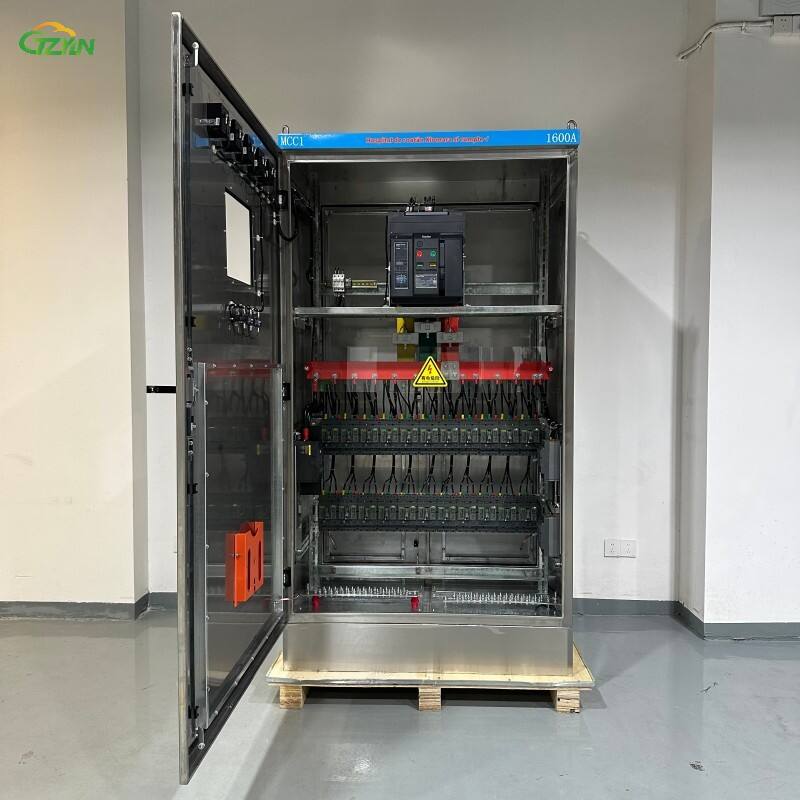The Critical Role of Outgoing Cabinets in Modern Power Systems
Core Functions of Power Distribution Cabinets
Outgoing cabinets serve as essential components in the power distribution system by managing electricity flow from substations to various loads. These cabinets ensure effective distribution of power, playing a crucial role in maintaining operational stability across electrical networks. Moreover, outgoing cabinets protect electrical equipment from faults, overloads, and short circuits, thus enhancing the safety and resilience of power systems. According to a study on power distribution efficiency, implementing optimized power distribution strategies through effective outgoing cabinet usage can significantly reduce operational costs in facilities, showcasing their impact on energy efficiency.
Integration with Electrical Distribution Systems
The seamless integration of outgoing cabinets with electrical systems is fundamental to enhancing overall system reliability. These cabinets are designed to be compatible with different voltage levels and power ratings, adhering to stringent industry standards. Ensuring this compatibility is essential for maintaining the robustness of the electrical distribution infrastructure. For instance, a case study involving a metropolitan power grid demonstrated improved performance and reliability when modern outgoing cabinets were integrated, indicating successful adaptation and heightened efficiency within the power distribution systems.
Enhancing Grid Stability and Performance
Outgoing cabinets play a pivotal role in stabilizing electrical grids, especially amidst fluctuating demand and supply conditions. By incorporating innovative technologies, these cabinets enhance grid responsiveness and minimize downtime, thereby optimizing grid performance. For example, intelligent monitoring systems within outgoing cabinets can preemptively address potential disruptions, contributing to a more stable and reliable electrical grid. Industry reports underscore the correlation between modern outgoing cabinet usage and improved grid performance, highlighting the advantages of integrating advanced technologies in power distribution networks.
Optimizing Energy Flow: Principles of Efficient Power Distribution
Balanced Load Management Strategies
Efficient power distribution relies heavily on effective load management across outgoing cabinets to prevent overload and prolong equipment lifespan. Strategies such as phase balancing and compartmentalization are key in achieving this equilibrium. These techniques ensure that power is distributed evenly across circuits, minimizing the risk of overloading and equipment stress. Engineering studies support that these strategies significantly improve energy efficiency, reducing operational wear and extending the life expectancy of electrical systems.
Voltage Regulation and Phase Alignment
Voltage regulation mechanisms within outgoing cabinets play a crucial role in maintaining consistent power quality. By ensuring that voltages remain within designated limits, they prevent disruptions in the electricity supply that could lead to equipment damage or inefficiencies. Phase alignment is equally important as it contributes to operational efficiency by aligning power phases to reduce energy losses. According to regulatory standards, proper voltage regulation and phase alignment are crucial, with specific benchmarks indicating acceptable deviation levels to maintain optimal functionality.
Minimizing Energy Loss Through Advanced Components
Advanced components such as high-efficiency transformers and smart relays are pivotal in minimizing energy loss within power distribution systems. These components enhance the overall efficiency of outgoing cabinets by optimizing the conversion and relay of electrical power. Innovations in green energy technology have led to recent advancements, as reported in energy journals, highlighting components that significantly reduce wasted energy. By integrating such advanced technologies, power distribution cabinet systems are optimized for greater efficiency and sustainability.
Space-Saving Design Innovations for Modern Facilities
Modular Configurations for Flexible Deployment
Modular configurations in power distribution systems provide custom solutions for varied facility sizes and plans. These designs allow businesses to optimize space usage while offering scalable options adaptable to future changes in infrastructure. By tailoring power needs according to specific business requirements, companies can not only conserve physical space but also achieve greater operational efficiency. For instance, a global data center operator used a modular design to double its capacity within the same footprint, showcasing modular design's potential in high-demand settings.
Vertical vs. Horizontal Layout Optimization
Choosing between vertical and horizontal layouts in power distribution systems greatly affects space utilization and efficiency. Vertical setups often offer superior space savings and accessibility, especially in high-density environments, whereas horizontal configurations excel in heat dissipation and ease of maintenance. Visual representations highlight these layouts' advantages, helping businesses decide based on their specific environment and needs. Industry experts generally recommend vertical setups for facilities with constrained space but note that horizontal layouts suit areas where heat management is crucial.
Integration with Existing Infrastructure
Seamless integration with existing infrastructure is critical, especially when retrofitting older systems with modern advancements. Compatibility ensures that businesses can upgrade without extensive overhauls while maximizing existing investment. Common challenges include matching old and new technologies and minimizing downtime during integration. Successful integrations, like a project where an old manufacturing plant incorporated new efficient cabinets and reduced energy costs by 15%, illustrate its benefits. Best practices—such as thorough site assessments and phased implementations—are essential for smooth transitions and augmented energy management.
Safety and Protection in Outgoing Cabinet Systems
Circuit Breaker Technologies for Overload Prevention
Circuit breaker technologies are crucial for preventing electrical overloads in outgoing cabinet systems. Recent advancements include smart breakers that provide real-time monitoring and can issue remote alerts. These innovations drastically reduce the risk of system failures, ensuring better protection and reliability. For instance, smart breakers can alert technicians to potential issues before they escalate into serious problems, thereby minimizing downtime and maintenance costs. Statistics indicate that modern breaker technologies experience failure rates significantly lower than outdated systems, proving their efficacy in safeguarding electrical infrastructure.
Insulation Materials and Thermal Management
Selecting the appropriate insulation materials is vital to reducing thermal risks in power distribution cabinets. Insulation helps manage heat within electrical systems, preventing overheating and potential damage. Commonly used materials include fiberglass, mica, and ceramic, each offering distinct thermal properties. A comparative analysis of these materials reveals that ceramic insulation, for example, provides excellent temperature resistance, making it ideal for high-stress environments. Studies on material performance have demonstrated the long-term benefits of these materials in enhancing thermal management, conserving energy, and increasing the lifespan of electrical components.
Grounding Systems and Fault Current Mitigation
Effective grounding systems play a critical role in enhancing electrical safety and mitigating fault currents in outgoing cabinets. These systems help divert excess voltage safely away from critical infrastructure, preventing damage and ensuring operational continuity. Various grounding techniques are available, such as solid grounding and resistance grounding, each suited to different use cases. Insights from electrical engineering experts highlight trends that favor innovative grounding practices tailored to contemporary electrical installations. By staying abreast of these trends, facilities can enhance their safety measures and optimize their electrical systems for both efficiency and protection.
Smart Monitoring and IoT Integration in Power Distribution
Real-Time Load Tracking and Analytics
Real-time load tracking technologies offer significant advantages by enhancing the efficiency of power distribution management. These technologies allow operators to capture and analyze data instantaneously, enabling informed decisions to optimize energy usage. Various analytics tools such as energy dashboards and predictive analytics software provide actionable insights, helping organizations to intelligently manage consumption and reduce wastage. For example, a case study from a major utility company showed a 15% reduction in energy costs after implementing real-time monitoring systems across their network. This demonstrates how such systems can streamline operations and effectively manage load.
Remote Control Capabilities for Adaptive Management
Remote monitoring systems significantly enhance the control over power distribution, enabling adaptive management to meet changing energy demands. These systems provide operators with the ability to adjust settings and respond to fluctuations in real-time, ensuring optimal performance and reducing disruptions. Adaptive management is crucial as it allows businesses to maintain seamless operations despite varying loads and activities. Success stories abound, such as a manufacturing firm that improved its grid management efficiency by 20% through the adoption of remote control technologies, showcasing the transformative impact of these solutions.
Predictive Maintenance via Sensor-Driven Insights
IoT-enabled sensors are pivotal in facilitating predictive maintenance, substantially reducing unexpected failures and downtimes. These advanced sensors continuously monitor the status of power distribution cabinets, providing early warning signs for potential issues. By implementing sensor systems, businesses can predict maintenance needs and address them proactively, thus maximizing operational efficiency. Methodologies for sensor systems integration involve using wireless communication and cloud-based platforms to synchronize data collection and analysis. Quantitative data from industry reports show maintenance cost reductions of up to 30% with the adoption of predictive approaches, underscoring the economic benefits.
FAQs
What are the main functions of outgoing cabinets?
Outgoing cabinets manage the flow of electricity from substations to various loads, ensure effective power distribution, and protect electrical equipment from faults, overloads, and short circuits.
How do outgoing cabinets enhance grid stability?
They incorporate innovative technologies that enhance grid responsiveness, minimize downtime, and improve grid performance through intelligent monitoring systems.
What components help minimize energy loss in power distribution systems?
High-efficiency transformers and smart relays are pivotal components that optimize the efficiency of outgoing cabinets by reducing energy loss.
What benefits do modular configurations offer in power distribution?
Modular configurations provide custom solutions to optimize space usage, offering scalable options adaptable to future changes in infrastructure, conserving space, and achieving greater efficiency.
How do IoT-enabled sensors contribute to maintenance in power distribution systems?
These sensors facilitate predictive maintenance by continuously monitoring the cabinet status, providing early warning signs, thus reducing unexpected failures and maximizing operational efficiency.
Table of Contents
- The Critical Role of Outgoing Cabinets in Modern Power Systems
- Optimizing Energy Flow: Principles of Efficient Power Distribution
- Space-Saving Design Innovations for Modern Facilities
- Safety and Protection in Outgoing Cabinet Systems
- Smart Monitoring and IoT Integration in Power Distribution
-
FAQs
- What are the main functions of outgoing cabinets?
- How do outgoing cabinets enhance grid stability?
- What components help minimize energy loss in power distribution systems?
- What benefits do modular configurations offer in power distribution?
- How do IoT-enabled sensors contribute to maintenance in power distribution systems?




